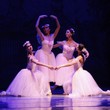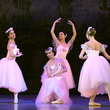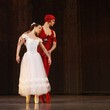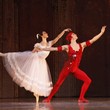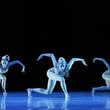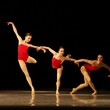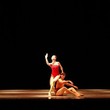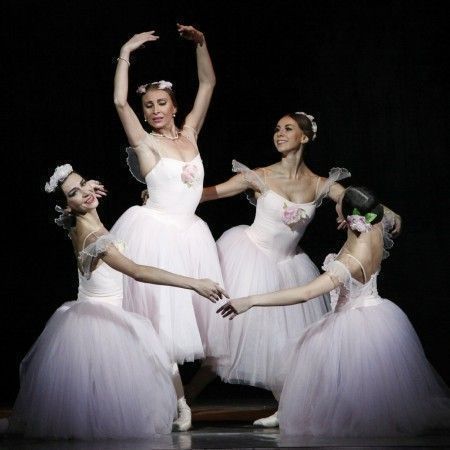
 Theater
TheaterSymphony Of The Dance
Date and time
24 February 2017, Friday 18:00
P R E M I E R E SYMPHONY OF THE DANCE: WORLD CLASSIC AND MODERN (one act ballets)
Choreography by M. Fokin Carl Maria von Weber Le Spectre De La Rose
A young girl, returning from the ball, falls asleep in her chair. Bright rose falls from her hand. In the dream, she dreams of the Rose spirit that invites her to a rapid waltz. On the last phase the vision disappears and she wakes up. "This is the spirit of the flower, aroma of which reminds of a loved one, of dancing with him at the ball, the exchange of words, perhaps a kiss. This is the spirit. This is a dream. This fragrance of the rose, fondling its delicate petals.
Pas de Quatre is a ballet divertissement choreographed by Jules Perrot in 1845, on the suggestion of Benjamin Lumley, Director at His Majesty's Theatre, to music composed by Cesare Pugni. On the night it premiered in London, (12 July 1845) it caused a sensation with the critics and the public alike. The reason for this was that it brought together, on one stage, the four greatest ballerinas of the time — in order of appearance, Lucile Grahn, Carlotta Grisi, Fanny Cerrito, and Marie Taglioni. Pas de Quatre captured the essence of the Romantic style as the ballerinas danced with demure lightness, delicacy, and poise. The steps demand that each area of classical ballet technique is executed. These areas include adagio movements, petite allegro, grand allegro, fast footwork, graceful changes of position, and the elegant and fluid arm movements that have become a signature element of Pas de Quatre. Each ballerina has an individual variation, which are performed in succession between an opening and finale that are danced by all the ballerinas together. These variations were choreographed for the ballerina premiering in each role, and were designed to display the best features of each.
Closer then Love ballet to music by J. Pachelbel, G. F. Handel, C. W. Gluck, A. Vivaldi, E. Bosso, A. Marchello Choreography, staging, costumes - Artem Shoshyin «Closer Than Love» is a one act ballet about the most important feeling in every person’s life, and in the life of all mankind. The theme of this performance is the path of the rise of the relationship between lovers – from the blossoming of love, through breakup, to that which remains after love’s death – to emptiness and fear of loneliness. Three stages of love are symbolized by three pairs of artists. Each stage of the relationship in the performance turns into a thrilling story, filled with deep emotions, psychological allusions and pulsating sensations of true passion. Their dance proposes deep questions: «What does love look like? Is it real – true love? Does love exist on this Earth?»
Choreography by M. Fokin Carl Maria von Weber Le Spectre De La Rose
A young girl, returning from the ball, falls asleep in her chair. Bright rose falls from her hand. In the dream, she dreams of the Rose spirit that invites her to a rapid waltz. On the last phase the vision disappears and she wakes up. "This is the spirit of the flower, aroma of which reminds of a loved one, of dancing with him at the ball, the exchange of words, perhaps a kiss. This is the spirit. This is a dream. This fragrance of the rose, fondling its delicate petals.
Pas de Quatre is a ballet divertissement choreographed by Jules Perrot in 1845, on the suggestion of Benjamin Lumley, Director at His Majesty's Theatre, to music composed by Cesare Pugni. On the night it premiered in London, (12 July 1845) it caused a sensation with the critics and the public alike. The reason for this was that it brought together, on one stage, the four greatest ballerinas of the time — in order of appearance, Lucile Grahn, Carlotta Grisi, Fanny Cerrito, and Marie Taglioni. Pas de Quatre captured the essence of the Romantic style as the ballerinas danced with demure lightness, delicacy, and poise. The steps demand that each area of classical ballet technique is executed. These areas include adagio movements, petite allegro, grand allegro, fast footwork, graceful changes of position, and the elegant and fluid arm movements that have become a signature element of Pas de Quatre. Each ballerina has an individual variation, which are performed in succession between an opening and finale that are danced by all the ballerinas together. These variations were choreographed for the ballerina premiering in each role, and were designed to display the best features of each.
Closer then Love ballet to music by J. Pachelbel, G. F. Handel, C. W. Gluck, A. Vivaldi, E. Bosso, A. Marchello Choreography, staging, costumes - Artem Shoshyin «Closer Than Love» is a one act ballet about the most important feeling in every person’s life, and in the life of all mankind. The theme of this performance is the path of the rise of the relationship between lovers – from the blossoming of love, through breakup, to that which remains after love’s death – to emptiness and fear of loneliness. Three stages of love are symbolized by three pairs of artists. Each stage of the relationship in the performance turns into a thrilling story, filled with deep emotions, psychological allusions and pulsating sensations of true passion. Their dance proposes deep questions: «What does love look like? Is it real – true love? Does love exist on this Earth?»
